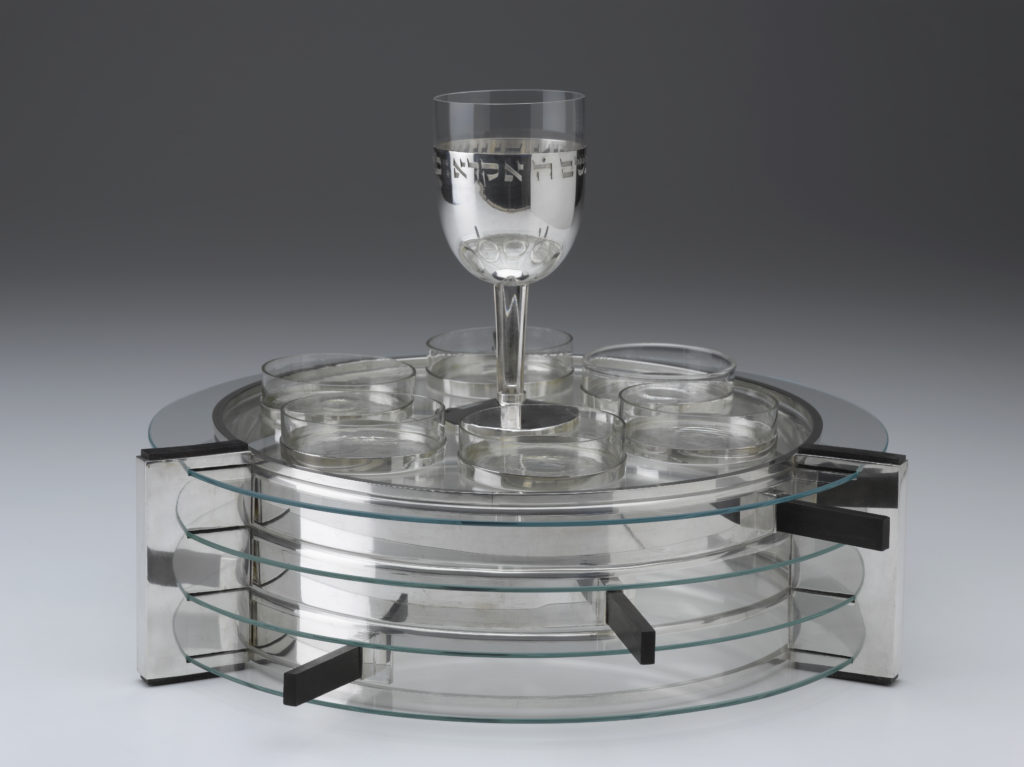Passover Seder Set with Plates, Dishes, and Wine Cup (work of art)
Artwork Info
Key Ideas
- This silver-and-glass Seder (say-dur) set emphasizes simplicity. It is both modern-looking and functional. It was designed for serving symbolic, ceremonial foods that are traditionally eaten during the Passover Seder or feast. “Seder” is a Hebrew word that means “order.”
- Wolpert was strongly influenced by the Art Deco movement. This influence is evident in the set’s clean lines, simplicity, and lack of ornamentation.
- The artist was one of the most influential designers of Jewish ceremonial objects in the 1900s. This Passover Set is based on an original set designed and created for the Jewish Museum in New York in 1930. The original set has not been found.
- The Kiddush cup in the set includes an engraved Hebrew inscription that translates to “I raise the cup of deliverance and invoke the name of the Lord” (Psalm 116:13).
Learn More
This Seder set was created by Ludwig Yehuda Wolpert, one of the most influential designers of Jewish ceremonial objects in the 20th century. He was inspired by the Art Deco style’s clean geometry and simplicity. Born in Germany, Wolpert studied goldsmithing and metalwork at the School of Arts and Crafts in Frankfurt-on-the-Main. He is credited with introducing modernist design to the creation of Jewish ceremonial objects. In 1933 Wolpert emigrated to Palestine, to escape the threat of Germany’s Nazi regime. From 1935 to 1956, he taught metalwork at the New Bezalel School for Arts and Crafts in Jerusalem. He was invited to New York City in 1956, where he established the Tobe Pascher Workshop for Jewish ceremonial objects at the Jewish Museum. He lived and worked in the United States until his death in 1981.
Wolpert’s modernist Seder set is made of silver, glass, and ebony wood. Matzah (the thin, cracker-like bread that is traditionally eaten by Jewish people during Passover) would have been placed on the glass shelves, one for each of the three pieces of matzah used as part of the formal Seder ceremony. The six glass dishes were used to serve symbolic foods. The wine cup is decorated with a Hebrew verse that translates to “I raise the cup of deliverance, and invoke the name of the Lord” (Psalm 116:13).
Passover, or Pesach (pay-sock), commemorates the liberation of the Israelites from enslavement in Egypt. The main ritual is a family meal known as a Seder. Traditionally the Seder begins with prescribed prayers, followed by the retelling, maggid (ma-geed), of the story of the Exodus, the blessing of wine and bread, singing songs, and reciting verses of praise (psalms). The bread, or matzah, is made from a mixture of water and special flour without yeast, to symbolize the Israelites’ hurry to leave Egypt. Other symbolic foods that are served include maror (mah-roar), bitter herbs to symbolize the bitterness of slavery; haroset (ha-row-set), a blend of fruit and nuts with wine, to represent the mortar used in the building of Pharaoh’s city; and a lamb’s shank (leg) bone, to honor the special Passover or Paschal sacrifice, when the Israelites marked their doorposts before the Exodus.
Additional Resources
Resources for Teachers:
- Read an article about the artist and his work.
- Read about the art movement that influenced Wolpert’s work.
Resources for Students:
- Explore four unique items designed for use at the Passover Seder.
- Listen to a podcast about this work of art.
- Learn more about setting up a traditional Seder plate.

